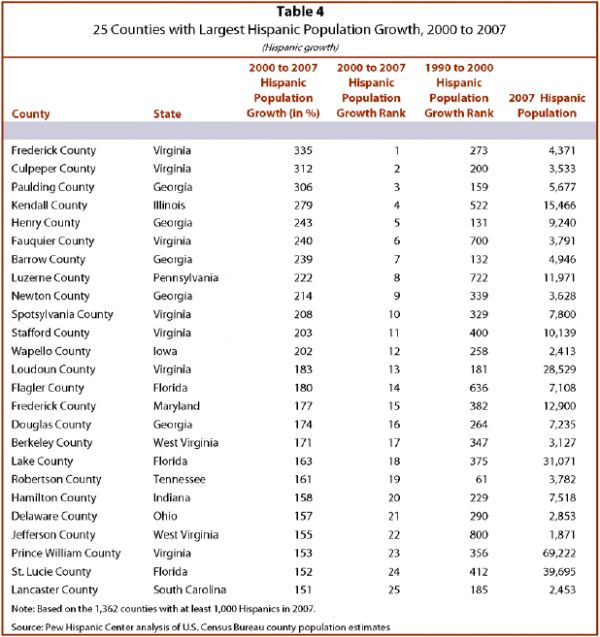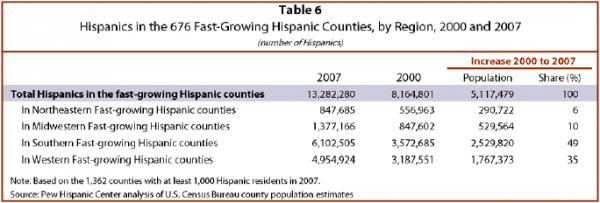Since 2000, the nation’s Hispanic population has grown by 29%. In half of the counties with at least 1,000 Latino residents, the Hispanic population grew by at least 41% since 2000. Map 2 shows the 676 counties that experienced Hispanic growth rates at or above this nationwide county average. These fast-growing Hispanic counties in the new century tend to be counties that had smaller Hispanic population bases in 2000. In 2000, about one-quarter (23%) of the nation’s Hispanic population resided in the fast-growing counties (Table 3). Because of the continued dispersion of Hispanics, by 2007 some three-in-ten Hispanics resided in these fast-growing counties.


Overall, the Hispanic population in the 676 fast-growing counties grew by 63%. However, many of the fast-growing counties had Hispanic population growth rates above that.

Dispersion by Metropolitan versus Non-Metropolitan County
In the new century, Hispanics have been dispersing overwhelmingly to counties in metropolitan areas.4 The Hispanic population residing in the 676 fast-growing Hispanic counties increased by 5.1 million from 2000 to 2007 (Table 5). Almost 4.8 million of that population growth, or 94%, has been in metropolitan counties. Two-thirds (447 counties) of the 676 fast-growing counties are metropolitan counties.

The importance of metropolitan counties is evident in the Table 4 list above of the 25 counties with the largest Hispanic population growth rates in the new century. Of the 25 fastest-growing counties, 22 are metropolitan counties. The only exceptions are Culpeper (Virginia), Wapello (Iowa), and Lancaster (South Carolina) counties, which are in micropolitan (non-metropolitan) statistical areas.
The fact that Hispanics are dispersing to counties in metropolitan areas does not mean those counties have large Hispanic populations. Figure 1 above shows that Hispanics are increasingly residing in counties that had fewer than 10,000 Latinos in 1990—many of which are metropolitan counties, according to the Census Bureau definition. In fact, half of the metropolitan counties in the country had Hispanic populations of 2,315 or less in 1990.
Dispersion by Region
In this decade, the bulk of the Hispanic population growth in fast-growing counties has occurred in the South and the West. Southern counties alone account for almost half (2.5 million) of the 5.1 million increase in the Latino population in the fast-growing counties, while Western counties account for over one-third (Table 6).5 A majority of the fast-growing Hispanic counties (58%) are in Southern states. Georgia and North Carolina have more fast-growing Hispanic counties (51 each) than any other state.





